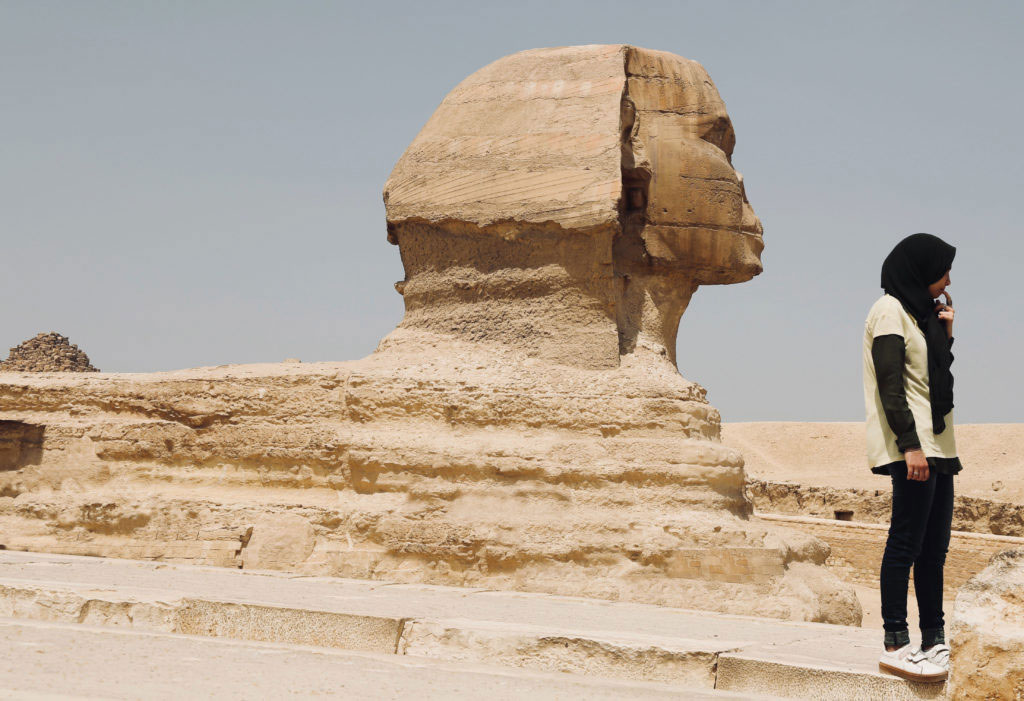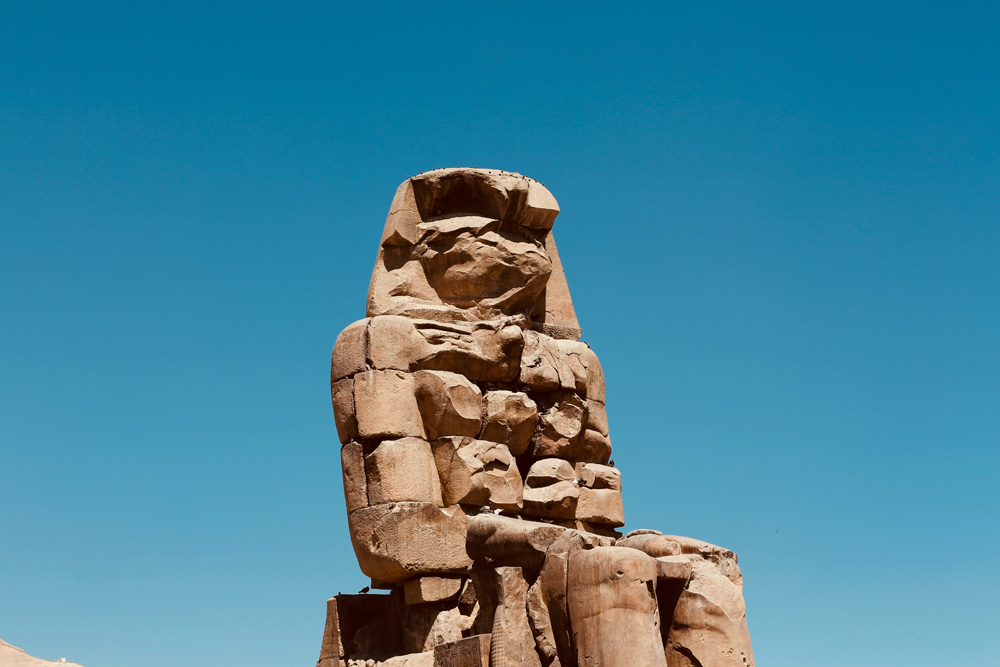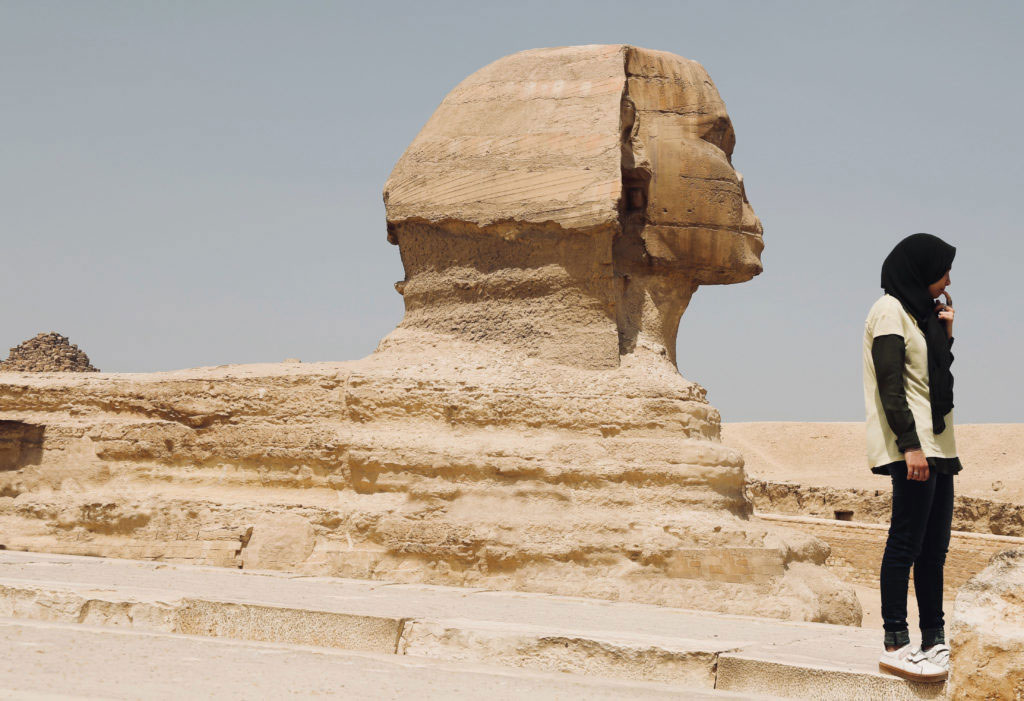
Why do you come to Egypt? Do you come to gain a dream, or to regain lost dreams of old; to gild your life with the drowsy gold of romance, to lose a creeping sorrow, to forget that too many of your hours are sullen, grey, bereft? What do you wish of Egypt?1
When I was young, Sekhmet, the Ancient Egyptian Lady of Slaughter, was my favorite goddess. I didn’t know her name, or that she was the goddess of war, or that she was a goddess at all. I knew her as the straight-backed, cat-faced statue facing the Temple of Dendur in the Metropolitan Museum of Art in New York City. We lived in Brooklyn and my parents were always looking for ways to enrich our daily urban landscape. My mom preferred the Lohan Buddhas in the Met, my dad preferred the dinosaurs in the American Museum of Natural History, but I loved the gold-masked mummies of Ancient Egypt at the Met that I believed might, just might, come to life and curse me and my parents.
It was a risk that I was willing to take as we walked from the Met’s lofted entrance hall down the long crowded hallways papered with images and papyri from The Book of the Dead. We would speed past the Roman-era mummies, whose painted faces were too human, their accessibility a betrayal of the inaccessible magic of Egypt. The tomb treasures and hulking sarcophagi were worth pausing to look at on our way to the Temple. They were connected to the danger and mystery of it all and, unlike with the later mummies, I could not imagine myself in the carved sarcophagi. I never wanted to see myself reflected in Ancient Egypt. I never wanted it to be real. It lived in the same corner of my imagination as knights and dragons, pirates and their stolen loot. And so I would wend my way, parents in tow, to the huge, glass-fronted hall bordering Central Park and Fifth Avenue, home to the pharaohs and priests of Ra. I would look up at Sekhmet’s stone face, skirt past the stone crocodile in the surrounding moat, and cross the marble steps to the Temple itself. Somehow the eighteenth-century graffiti carved into the stone was not a transgression of Egypt’s magic, but served to emphasize its age and its dreamlike purveyance. Nose to the sandstone, I wasn’t so much transported to the time of pharaohs as awed by it. Its treasures, so boundless, so ageless, had made it to the museum not just from across the ocean but across the millennia. It was older than New York, older than America, older than knights and dragons, older than the Bible.
I could not look away.
It is, I think, one of the most astounding facts in the history of man that a man was able to contain within his mind, to conceive, the conception of the Sphinx…. He who created it looked beyond Egypt, beyond the life of a man. He grasped the conception of Eternity, and realized the nothingness of Time, and he rendered it in stone.2
I grew up and studied history in college, focusing on European medieval knights and princesses, putting names and dates and reality to stories that first enthralled me as a child. I still have never been to Egypt, though I’m old enough now to know that Egypt, ancient and modern, is real, and that my enjoyment of its treasures are as much stolen as given. But the lure of Ancient Egypt never lost its grip on me. After college and graduate school, working in London, I would slip into the British Museum during my lunch break to look at the Rosetta Stone and at their Sekhmet statues. Now, living and working in Oxford, I go to the Ashmolean Museum and look at their Egyptian treasures. No matter how far I am from from the Temple of Dendur, I can’t leave its shadow.
It is, I think, one of the most astounding facts in the history of man that a man was able to contain within his mind, to conceive, the conception of the Sphinx…. He who created it looked beyond Egypt, beyond the life of a man. He grasped the conception of Eternity, and realized the nothingness of Time, and he rendered it in stone.2

Something about Ancient Egypt is special, is different. Its gold isn’t just gold, but the melted sun of Ra; Tutankhamun’s mask isn’t just a funerary mask, but the eyes of a millennia-old king challenging us. It has a power that conjures dreams of finding some un-catalogued treasure in a museum or library that will bloom into an adventure. Ancient Egypt’s treasures have a lure, a palpable pull, even a threat that stirs us in a way our own gilded palaces and skyscrapers do not. That it has survived the test of time—so much time—is part of the magic. When Cleopatra became pharaoh and had her affairs with Julius Caesar and Marc Anthony, she was further away from the age of pyramid building than we are to her reign. Most everything about Ancient Egypt feels improbable to the point impossibility.
And yet we can gaze at pharaonic treasure, often as beautiful and impressive as the day it was created, and feel wonderment. How can it be? How can an empire so powerful reach out to us across thousands of years—yet itself be gone, literally dissolved into the sand? But Ancient Egypt isn’t simply a lesson in impermanence. Unlike other great empires that rose and fell—Rome, Greece, beyond—Ancient Egypt has an air of otherness around it. Who hasn’t felt a chill when leaning down to look at a mummy in a museum? Through its artifacts and treasures, Ancient Egypt thrills us. We might think of trips to see mummies as a childlike pursuit. But we encounter Ancient Egypt everywhere—in Agatha Christie’s mysteries, in movies like The Mummy, even in the Assassin’s Creed Origins computer game. When King Tutankhamun’s’s gold mask toured America in the mid-twentieth century, millions went to see it, waiting hours for the privilege. When one woman in Los Angeles finally got to the glass box, she leaned forward to see the famous mask—and saw the reflection of the man standing next to her. It was Cary Grant. She fainted, and when she awoke, she claimed she had been “overcome by the charm of her two favorite people.”3
This attraction to Ancient Egypt and its treasures is far from modern: Alexander the Great, Julius Caesar, Napoleon—iconic conquerors spanning centuries—were all similarly entranced. Great men, their hubris brought them to seek the glory and divinity of a pharaoh.
I can imagine the most determined atheist looking at the Sphinx and, in a flash, not merely believing, but feeling that he had before him proof of the life of the soul beyond the grave, of the life of the soul of Khufu beyond the tomb of his pyramid. Always as you return to the Sphinx you wonder at it more, you adore more strangely its repose, you steep yourself more intimately in the aloof peace that seems to emanate from it as light emanates from the sun. And as you look on it at last perhaps you understand the infinite.4
After Napoleon’s conquest of Egypt, a new age of Egyptian exploration began, the one that feeds so much of our imagination. This was the wild west of early Egyptology, an age that makes even non-archeologists shudder at the thought of tomb entrances dynamited and artifacts deliberately destroyed as part of the competition between countries and explorers along the Nile. Slowly, the hunger for Egypt’s wealth transformed into more reverence and care, thanks in large part to a woman who ended up in Egypt unexpectedly, drawn into an adventure and a love affair with Ancient Egypt that would last the rest of her life. Amelia Edwards (1831-1892) was an English author with middling fame who ended up in Egypt on a whim when her next planned trip around Europe was ruined due to ceaseless rain. As Edwards put it, “Here, then, without definite plans, outfit, or any kind of Oriental experience, behold us arrived in Cairo on the 29th of November 1873, literally, and most prosaically, in search of fine weather.”5
As she began her tour of the country, she kept meticulous notes, which became her book A Thousand Miles Up the Nile, letting us watch as this Victorian woman succumbed to Egypt’s thrall. By the time Edwards went to Egypt, she was as familiar with images of the pyramids as we are today. But when she saw them in person, her skepticism—her assumption that they would be one more monument off the bucket list—shattered.
It is only in approaching them, and observing how they grow with every foot of the road, that one begins to feel that they are not so familiar after all. But when …the Great Pyramid in all its unexpected bulk and majesty towers close about one’s head, the effect is as sudden as it is overwhelming. It shuts out the sky and the horizon. It shuts out all the other Pyramids. It shuts out everything but the sense of awe and wonder. For it is no easy task to realize, however imperfectly, the duration of six or seven thousand years; and the Great Pyramid, which is supposed to have been some four thousand two hundred and odd years old at the time of the birth of Christ, is now in its seventh millenary. Standing there close against the base of it…the Writer suddenly became aware that these remote dates had never presented themselves to her mind until this moment as anything but abstract numerals. Now, for the first time, they resolved themselves into something concrete, definite, real. It was as if one had been snatched up for an instant to some vast height overlooking the plains of Time, and has seen the centuries mapped out beneath one’s feet.6
It is just that—the ability to see centuries, millennia even—mapped out so simply that marks Ancient Egypt’s wealth as astounding not just on an archaeological level, but on a personal, human level as well. When we look at a pharaoh’s mask, a Sphinx, or even a temple transported across the world to New York City, we are confronted with the span of our history and the mysteries it contains; when we remember that Cleopatra and Julius Caesar considered the Great Pyramid with the same awe and intimidation thousands of years after it was built, we can’t help but feel a thread of empathy tying our humanity to these figures, themselves of so long ago they are more like stories than history. To consider Ancient Egypt and all its influence is to consider time itself on the most fundamental level. No wonder we cannot hold the weight of that thought for long and choose to weave in mummy curses and thrilling tales of adventure—we turn it into a story, true enough to visit in a museum, but distant enough that we can gaze up at Sekhmet, as a child, as an adult, and stare into the eyes of the goddess of war.
We tell ourselves that she is not staring back. But we know, as time has proven, that she will survive us all the same. ♦
From Parabola Volume 43, No. 1, “Wealth,” Spring 2018. This issue is available to purchase here. If you have enjoyed this piece, consider subscribing.
1 Robert Hitchens, The Spell of Egypt (London: Hodder and Stoughton, 1910), 3.
2 ibid, 18-19.
3 http://www.drhawass.com/wp/the-madness-named-tutankhamun/
4 Hitchens, 19-20.
5 Amelia B. Edwards, A Thousand Miles Up the Nile, (Century London, 1982 reprint), 3.
6 ibid, 13-14.
